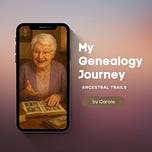One of my latest projects is to create additional elements for my digital downloads. One of the favourite ones available in the Essential Genealogy 2.0 Academy is the Family History Writer’s AI Toolbox.
Today’s project took a new digital download called AI Image Generators for Family History and transformed it into an explanatory Podcast with help from NotebookLM.
The audio file above is an edited version of the podcast created in NotebookLM by the team of two AI voices. First, I uploaded the AI Image Generators for Family History file to Descript, a favourite media editing tool, and used the wizardry of the Descript Underlord to remove filler words, adjust the tone and edit out unwanted content. Then I asked ChatGPT to create an image to go with this blog post.
Whimsical image by ChatGPT, August 2025
In today's digital age, preserving and visualising our family history has taken a radical leap forward. If you've ever peered at a faded family photograph or deciphered names on a crumbling census record and wished for more, your time has come. Thanks to AI image generators, we can now connect with the past in ways previously unimaginable. Let's embark on this visual journey and explore how AI tools elevate family history projects.
Discovering the Power of AI
Imagine being able to bring your ancestors to life visually, gaining insight into the nuances of their world through images crafted by intelligent technology. Our mission is to explore why experimenting with various AI tools is paramount to achieving the visuals you desire. The myriad of options might seem overwhelming at first, but each tool comes with distinctive strengths that can tailor your story to perfection.
Navigating the AI Landscape
AI tools like DALL-E 3, which you can access through chat platforms such as GPT, epitomise flexibility and creativity with edits. Its ability to interpret complex prompts makes it ideal for restoring damaged photos or crafting scenes enriched with period-specific detail.
On the other hand, Canva's Magic Media, seamlessly integrated into a design tool familiar to many, offers easy, quick illustrations for family trees or presentation slides.
For those needing character consistency, Leonardo AI stands out. It's perfect for showcasing someone, like a great-grandfather, at varying life stages, offering continuity across multiple historical narratives.
If speed and high-quality output are your goals, Google's Gemini model serves as an invaluable resource for rapid historical illustrations or brainstorming.
For those willing to invest, a platform like Abacus AI provides a spectrum of generators under one roof. This is beneficial for creating diverse characters or developing styles for vast family tales. Experimenting across these offerings underscores a crucial point—it's about matching the tool with your needs.
Strategically Choosing Your Tools
The journey begins by defining your story. Visualise the setting before diving into the technicalities. Is it a scene among Welsh coal miners from 1906 or an 1880s English farm family? Consider the attire, surroundings, and mood.
Once clarity is achieved, select the tool that complements your vision, whether Leonardo for faces or DALL-E for intricate details. Be prepared to adapt and iterate during the refining process, particularly when encountering typical AI anomalies, such as extra fingers or distorted expressions. Switching tools or integrating manual edits via Canva when necessary can resolve these quirks. This strategic flexibility enhances your storytelling.
Bringing the Past to Life
For those venturing into this digital exploration, it's about thinking creatively, akin to directing a film of your family's history. Instead of accepting the first AI-generated image, fine-tune your prompts, document your progress, and maintain context. Annotate your visuals with notes indicating their purpose, such as generating a 1920s style for a great aunt. Incorporating these vivid AI representations alongside actual documents, maps, and photographs enriches the narrative, providing texture and immersion. Visualising an ancestor's village, even without existing photos, becomes reality, connecting past to present intricately.
Next Steps for History Enthusiasts
Now, it's your turn. Consider which tool might help you visualise a cherished family photo or a scene described in an old correspondence. Contemplate how combining different tools might narrate your family’s story more vividly. Embark on this exploration with excitement and refine your family's visual history.
Happy exploring!













Share this post